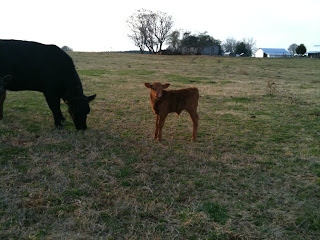Hey Folks,
We posted some pictures on our new Facebook page of some of our farm animals. Living on a farm we enjoy being constantly around animals. While some of them provide for our livelihood, others are pets or guardians. Occasionally these lines become blurred.
Case in point, Ferdinand.
Ferdinand, or “Dumplings” as our grandmother called her, was a poultry chicken. Her origins are not completely clear, but she probably grew up in a chicken house and was on a truck bound most likely for a processor the fateful day she fell out of the truck and bounced onto the road in front of our house. When we found her, she had wandered in our front yard, undoubtedly confused but cheerfully optimistic about the fortuitous circumstances that had helped her escape fate as a drumstick.
At the time we had a flock of bantam hens and roosters that roamed freely all over the yard, their metallic-hued feathers reflecting in the sunlight. Compared to the others, Ferdinand’s plain white feathers made her easy to spot. At first, we weren’t quite sure what to do with her, surely she wasn’t smart enough to stick around, not wander off into the woods, or into the jaws of some lucky coyote. In the very least we hoped she would at least lay some eggs for us.
Contrary to our skepticism, we noticed that Ferdinand had taken to her newly found freedom with what can only be described as “zest.” This chicken was a real risk taker. Dad, who loves hanging out in the back yard in a lawn chair, sat down one summer evening with a slice of warm pizza and cold beer. Not realizing he was being stalked, Dad sat the plate down on his lap to take a sip of beer. When BAM! In a flash of feathers, Ferdinand reached out with her long neck, yanked the pizza of his plate, and took off with dad’s slice of pepperoni pizza dangling out of her mouth running just as fast as she could go.
Another time Ferdinand got an eye infection that made her really sick. Dad who has touch with animals that rivals a university-educated veterinarian performed a delicate, but necessary operation to remove the infected eye. Not only was dad’s surgery successful but after only a few days in a cardboard box and some antibiotic ointment, Ferdinand was back in action.
Though she was tough, she was the only chicken of ours to let you pick her up, or keep you company as you walked around the yard. When she wasn’t plotting to steal your food, she would even hop up in your lap and let you pet her. And when you stroked her feathers she would coo.
I only have one picture of Ferdinand, but it is a great one. In the photograph, she is sitting on her tree stump and is nestled against her boyfriend, one of our bantam roosters. The two of them look like one of those content older couples that have celebrated many wedding anniversaries together.
Ferdinand was part of our family for many years before she passed. She showed us that chickens can be warm and friendly and funny and definitely provide more than just a source of protein. Ferdinand also demonstrated that relationships can occur in the most unsuspecting of places among the most unlikely of creatures - something we would have never known had Ferdinand not escaped that produce truck.
Thank you for reading and we hope you have a great week!
 What does "working" mean you ask? Working cattle means assessing each cow's health and well being and learning as much about them as possible.
What does "working" mean you ask? Working cattle means assessing each cow's health and well being and learning as much about them as possible. 
